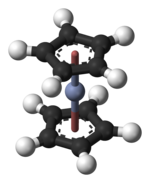Chromocene
|
|
|||
| Names | |||
|---|---|---|---|
|
IUPAC name
Bis(η5-cyclopentadienyl)chromium(II)
|
|||
| Other names
Dicyclopentadienylchromium(II)
|
|||
| Identifiers | |||
|
3D model (Jmol)
|
|||
| ChEBI | |||
| ChemSpider | |||
| ECHA InfoCard | 100.013.670 | ||
|
PubChem CID
|
|||
| RTECS number | GB7600000 | ||
|
|||
|
|||
| Properties | |||
| C10H10Cr | |||
| Molar mass | 182.19 g·mol−1 | ||
| Appearance | dark red crystals | ||
| Density | 1.43 g/cm3 | ||
| Melting point | 168 to 170 °C (334 to 338 °F; 441 to 443 K) | ||
| Boiling point | Sublimes (under vacuum) | ||
| Insoluble | |||
| Structure | |||
| Pseudooctahedral see Ferrocene |
|||
| 0 D | |||
| Hazards | |||
| Main hazards | Pyrophoric | ||
|
EU classification (DSD)
|
|||
| R-phrases | R20/21/22-R36/37/38 | ||
| S-phrases | S26-S37/39-S45 | ||
| NFPA 704 | |||
| Related compounds | |||
|
Related compounds
|
Fe(C5H5)2 Ni(C5H5)2 bis(benzene)chromium chromium(II) acetate |
||
|
Except where otherwise noted, data are given for materials in their standard state (at 25 °C [77 °F], 100 kPa).
|
|||
| Infobox references | |||
Chromocene, formally known as bis(η5-cyclopentadienyl)chromium(II), is a chemical compound with the condensed structural formula [Cr(C5H5)2]. Each molecule contains an atom of chromium bound between two planar systems of five carbon atoms known as cyclopentadienyl (Cp) rings in a sandwich arrangement, which is the reason its formula is often abbreviated as Cp2Cr. It is an organometallic compound as it has (haptic) covalent chromium–carbon bonds. Chromocene is structurally similar to ferrocene, the prototype for the metallocene class of compounds; however, as it has only 16 valence electrons, it does not follow the 18-electron rule. It is a paramagnetic compound and also highly reducing, both consequences of its low valence electron count. Like structurally related metallocenes, chromocene readily sublimes in a vacuum and is soluble in non-polar organic solvents.
Ernst Otto Fischer, who shared the 1973 Nobel Prize in Chemistry for his work on sandwich compounds, was the first to report a synthesis for chromocene. One simple method of preparation involves the reaction of chromium(II) chloride with sodium cyclopentadienide:
Such syntheses are typically conducted in THF; decamethylchromocene, Cr[C5(CH3)5]2, can be prepared analogously from LiC5(CH3)5. Chromocene can also be prepared from chromium(III) chloride in a redox process:
...
Wikipedia



